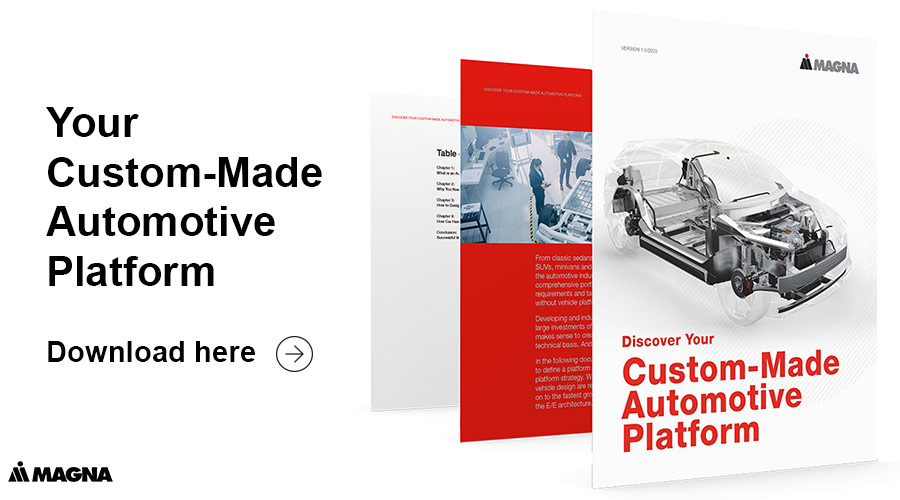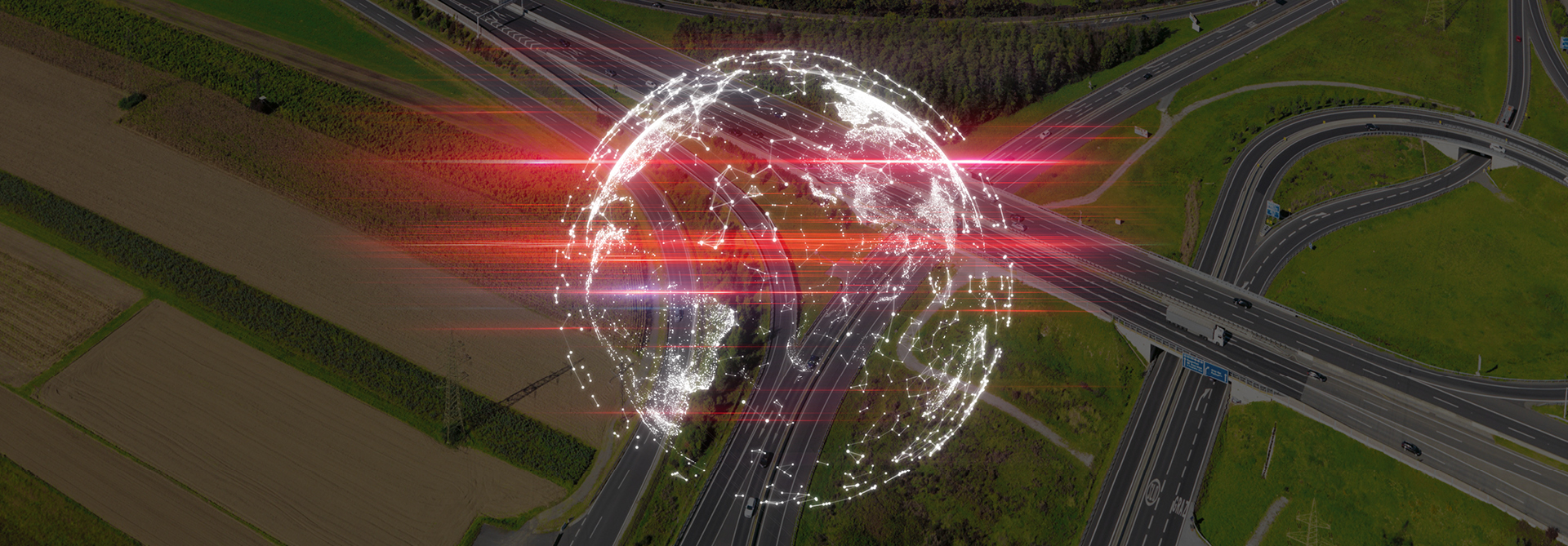
All About Car Platform Design + Free Whitepaper: Custom-Made Car Platform
- Willhelm Dietrich
- June 10, 2022
- 4-min read
As we have seen in previous articles, the automotive world is undergoing a major transformation right now. The advent of EVs and the slow phase-out of conventional car structures mean we are seeing vehicle platforms becoming increasingly adaptive as components and systems being implemented and combined more and more easily.
Carmakers are gaining unprecedented flexibility with new concepts and ideas, while OEMs and new entrants in the automotive market enjoy the numerous perks of vehicle brands whose structural foundations don’t have to abide by size and weight boundaries.
More than ever, the question of how to design a car revolves around finding a way that it can easily be adapted and changed into different variants. It is a question of finding the optimal through-line between a vehicle’s performance, its functionalities, as well as its styling – all while car engineers and designers have to adapt to the new conventions, or lack thereof, of EV manufacturing.
This article will explain car platform design in more detail. It outlines the essential factors of vehicle platform design, how they play into each other, the greatest challenges and opportunities that arise when designing a car platform, and what exactly makes a vehicle “modular.”
WHAT IS CAR PLATFORM DESIGN?
In essence, car platform design revolves around one big question: How can an automotive project be realized? To answer this question, the complete vehicle must be viewed from three perspectives.
Number 1: Geometry and structure
The first factor to regard in automotive design and architecture is, of course, the actual layout of the car platform. While the rise of EVs has significantly altered the way cars can be planned, they still need battery packs, a chassis, a body, a driver’s space and so on. The same automotive vision usually also comes with certain derivatives that alter its interior layout from the number of passenger seats to its height and the position of individual elements. With the increase in platform modularity (which we will talk about in a moment), structure must now also regard increasingly diverse size and weight classes. If a vehicle needs to support a varying number of battery packs, or more simply, is manufactured for two markets in two distinct locations, then its structure must be set out in a way that those changes don’t impact the rest of the car.1
Number 2: Functionalities and attributes
The second major factor that impacts the way a car is designed is the list of things it can do – aka its functions and technical attributes. Those range from complete vehicle functions such as interior acoustics, safety ratings, and top speed to system-specific factors such as the existence of electric & electronic architecture, certain ADAS systems, and components or battery performance. Functions are - in a manner of speaking - the “character” of a vehicle, highlighting how it performs in certain areas and what exactly it offers to consumers.2
Number 3: Styling or look-and-feel
Of course, features are not the only relevant aspect for end customers. Behind every vehicle idea there is a vision, a general image that this car should convey to the public. How it’s shaped from the outside, how it looks and sounds while in motion, how its interior is laid out, how it feels to enter, start and drive the car – all various large and small factors that define the customer experience and turn its manufacturer’s vision into reality. The styling of a vehicle often defines the boundaries in which a vehicle can be realized, but it can also function as the glue that binds a vehicle series together.3
How to bring car design together
Bringing these three perspectives in line with each other will, of course, not always go seamlessly. Structural limitations, functional requirements, and styling guidelines are often at odds with each other in several larger and smaller areas. Good automotive design requires finding the optimum middle ground between structure, functionalities, and styling.
For example, one of the numerous features relevant in the exact outline of a car is the way it interacts with the air it is moving through. Vehicle aerodynamics impact a car’s top speed and fuel/battery efficiency, as well as interior acoustics, and even how well dirt falls from its surface. Therefore, reaching aerodynamic efficiency by way of reducing the lift and (especially) drag forces affecting a vehicle is an important goal for vehicle designers.
Aerodynamics as an attribute is primarily dependent on the size and shape of a vehicle, as its front, the number of surface openings, etc. all affect the way a car “cuts” through the air. But if only the functional side of matters is regarded in terms of aerodynamics, then every vehicle on the market would essentially be shaped like a bullet train.
This would obviously impact not only the vehicle’s styling, but also come at an expense to the interior space and subsequently passenger comfort and other features, such as acoustics or a car’s interface.
Vehicle design has to find a middle ground among these three factors in a way that retains a minimal Cd (drag co-efficient) value, while not impacting other, potentially more relevant features or its styling. And of course, it must also abide by the structural preconditions set by its platform structure. This is true for all functions and attributes of a vehicle, and it requires a competent and reliable team of vehicle designers and architects as well as the simulation tools necessary to collect the data needed.
THE BIGGEST CHALLENGES FOR A CAR PLATFORM DESIGN
With that being said, there are still several factors to be considered when discussing automotive design.
New conventions on the EV market
EVs and technological developments have turned the inner workings of the automotive world upside down. Vehicles now have to adhere to significantly different customer standards that prioritize new values such as safety, sustainability, comfort, or software features. This comes in tandem with an evolving legal situation of ADAS systems or in-car entertainment. As the traditional powertrain is being replaced by electrified solutions, new components require manufacturers to change their supply networks, as well as their production processes. And given the all-electric nature of EVs, its E/E architecture now takes over a much more pronounced and central role inside the vehicle.
Of course, designers and architects are far from exempt in the wake of these changes. Driver automation must now be considered during planning. As infotainment features grow, so does the need to implement an HMI to fit into this new “computer on wheels” approach. And of course, both the changed powertrain and the influx of new manufacturers in the market has increased the speed in which new innovations and efficient concepts enter the market – with modularity and flexibility lying at the center of this new way of designing platforms.
Commonality across different markets and models
As platforms all revolve around repurposing components, communality is the name of the game when it comes to efficient platform design. Under the conditions set by the product vision and target market, the car platform must be devised in a way that it contains the most efficient set of components. It’s not only about how much of a car can be shared across all derivatives, but also how those components should be laid out and, even more importantly, what proportions they themselves need to have.
While a large and powerful battery is nice, it must be reshaped if its proportions stand in the way of another more important feature or a different car variant.
This is not restricted to derivatives only. As soon as a vehicle aims for a global or multi-regional release, conditions diversify drastically. From changing legal frameworks to the different conditions of the development infrastructure to the customer’s demands – a launch in multiple regions will always demand manufacturers to look at the efficiency of their design in a new way.
The great potential of modular vehicle platforms
Platform modularity has established itself as an answer to ever-increasing development speeds, rising costs, and an overall drive towards a more diversified product portfolio. Modularity is the concept of breaking up the complete vehicle into standardized components shared across a wider range of vehicles.
Automotive manufacturing will become ever more adaptive and fluid in the upcoming years – and vehicle designers play a major role in driving this trend.
A TRUSTED PARTNER FOR YOUR MODULAR VEHICLE PLATFORM
Magna has also already tapped into the trends of today and has developed adaptive and flexible platform solutions in a joint effort with partners and suppliers. As part of our automotive one-stop-shop service we can support new entrants to the vehicle market with a modular vehicle building set. Whether by using the platform as blueprints for a new automotive brand directly or for deriving a unique platform solution from it, Magna’s platform solutions can provide a much-needed foundation on which new automotive visions can set off their journey onto the road.
WHAT'S NEXT?
In summary, there are three perspectives to consider when discussing platform design and architecture:
- The vehicle structure in correlation with the layout of a platform
- The vehicle functional attributes, system functions & electronics
- The vehicle’s styling (including its derivatives.
Platform designers should align all three of these attributes in order to realize an automotive project. This task has changed with the advent of EVs and is now defined by a more unified and modular design within platforms and components alike, all while looking for ways to make platforms more streamlined and top hats more pronounced.
EV car design faces a paradox situation in which components become more common and unified across vehicles, all while the total vehicle diversity and designer’s freedom grow ever more. A huge diversity in vehicles, stemming from a degree of commonality within platforms never seen before and achieved by developing modular components that allow for such a development. However, this new standard can only be utilized to the fullest if platform makers recognize the tremendous importance of design and architecture and adhere to every single millimeter in platform design.
Stay connected with Inside Automotive!

Willhelm Dietrich
Wilhelm Dietrich is the global technical area head of complete vehicle & architecture at Magna Steyr Engineering, where he oversees four departments responsible for styling, vehicle architecture, vehicle integration and homologation. He joined Magna in July 2000 and holds a degree in mechanical engineering and business economics.
We want to hear from you
Send us your questions, thoughts and inquiries or engage in the conversation on social media.
Related Stories
Stay connected
You can stay connected with Magna News and Stories through email alerts sent to your inbox in real time.



